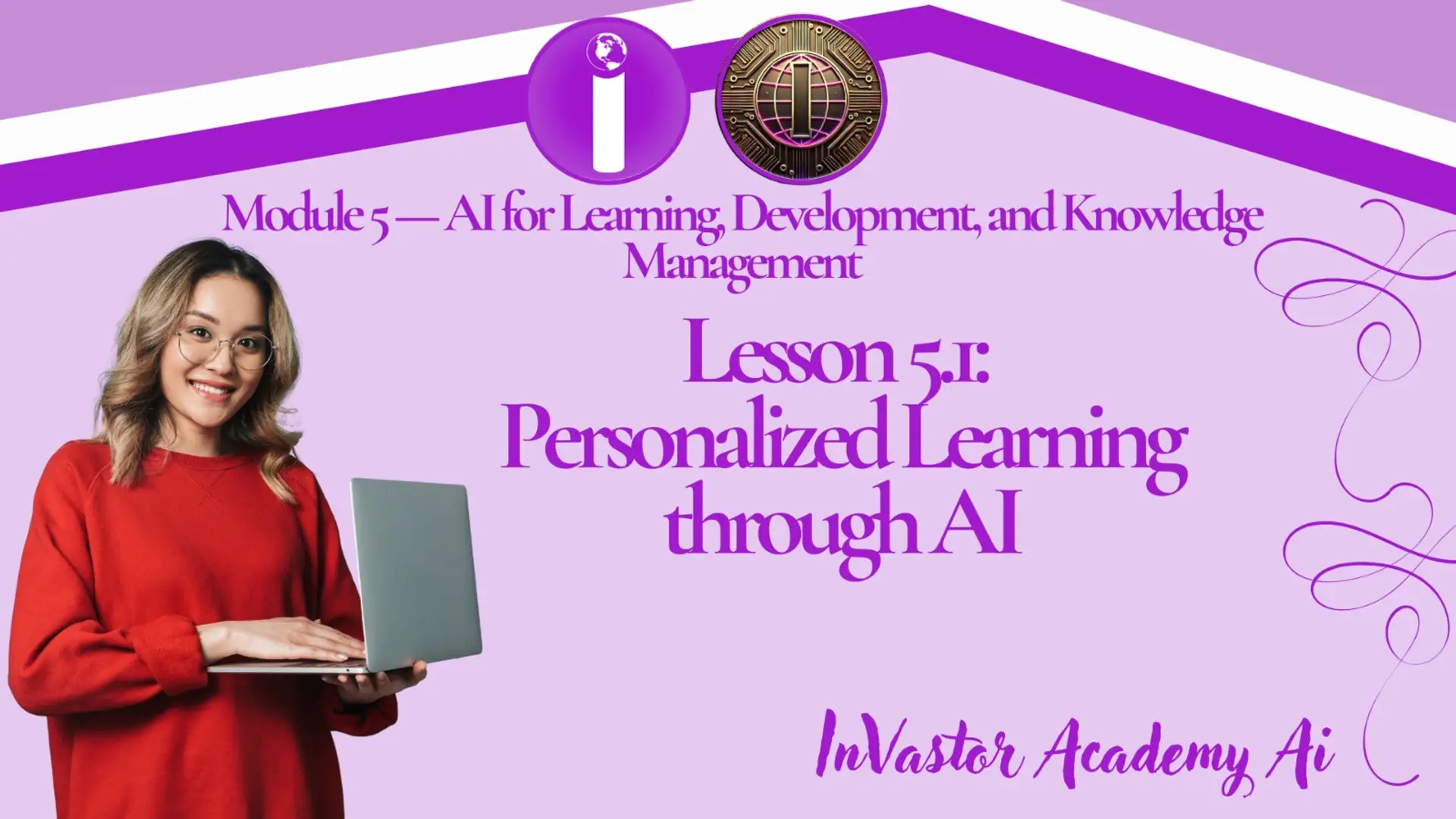

Module 5 — AI for Learning, Development, and Knowledge Management, Lesson 5.1 — Personalized Learning through AI
Module 5 — AI for Learning, Development, and Knowledge Management
Lesson 5.1 — Personalized Learning through AI
Learning Objectives
By the end of this lesson, learners will be able to:
- Understand how AI personalizes learning and development for employees.
- Explain the role of adaptive learning platforms in professional growth.
- Identify tools and techniques used in AI-driven personalized learning.
- Analyze the benefits and challenges of AI-based learning personalization.
- Apply best practices for integrating AI into organizational learning systems.
1️⃣ Introduction: The Shift Toward Personalized Learning
Traditional corporate learning often applies a “one-size-fits-all” approach — offering uniform training regardless of each employee’s skills, interests, or learning pace.
AI is transforming this by creating personalized learning experiences that adapt dynamically to the learner’s progress, preferences, and performance data.
With AI, organizations can deliver the right content, at the right time, in the right format, maximizing engagement and effectiveness.
2️⃣ How AI Personalizes Learning
AI-driven learning systems use data analytics, machine learning, and natural language processing to customize learning paths.
Here’s how it works:
- Skill Gap Analysis: AI assesses employee performance and identifies learning needs.
- Content Recommendation: Algorithms suggest tailored materials based on the learner’s goals, behavior, and interests.
- Adaptive Learning Paths: The system adjusts difficulty levels and topics in real time.
- Progress Tracking: AI monitors engagement, completion, and mastery for continuous improvement.
- Feedback and Support: Chatbots and virtual mentors provide instant assistance and motivation.
Example:
An employee struggling with data visualization in Excel receives AI-suggested micro-lessons and exercises targeting that skill gap, while another focusing on leadership development gets personalized scenario simulations.
3️⃣ Benefits of AI-Driven Personalized Learning
AI in learning and development (L&D) creates both individual and organizational value:
Benefit Description
🎯 Higher Engagement Content matches learner preferences and learning styles.
⏱️ Time Efficiency Employees focus on areas where improvement is most needed.
📊 Data-Driven Insights Learning analytics provide evidence-based performance metrics.
💬 Continuous Learning Culture AI nudges learners toward ongoing development and curiosity.
🧠 Improved Retention and Application Personalized pacing leads to deeper understanding and skill mastery.
4️⃣ Real-World Applications
Here are examples of organizations using AI to power personalized learning:
- IBM Watson Learning Platform: Uses AI to analyze employee learning patterns and recommend targeted learning paths aligned with career goals.
- LinkedIn Learning: Employs machine learning to suggest courses based on job title, skills, and interests.
- Coursera for Business: Customizes training content through predictive analytics and learner feedback data.
- Accenture’s myConcerto: Offers adaptive learning modules integrated with AI insights for skill development in real time.
These examples demonstrate how personalization enhances both learning outcomes and employee satisfaction.
5️⃣ Tools and Technologies in Personalized Learning
Some of the most widely used AI technologies for personalized L&D include:
- Adaptive Learning Platforms: Docebo, Cornerstone AI, EdCast, and LearnUpon.
- AI Coaching Systems: Replika AI Coach, Butterfly.ai, and BetterUp.
- Skill Intelligence Platforms: Gloat, Degreed, and Eightfold.ai.
- AI Chatbots for Learning Support: Used to answer FAQs, recommend resources, and track progress.
- Learning Analytics Dashboards: Provide real-time insights for L&D teams.
6️⃣ Challenges in Implementing Personalized Learning
While powerful, AI personalization also presents several challenges:
- Data Privacy and Consent: Employee data used for personalization must be protected and ethically managed.
- Algorithmic Bias: Unbalanced datasets can produce unfair learning recommendations.
- Change Resistance: Employees may distrust AI-driven learning paths.
- Integration Complexity: Linking AI systems with existing Learning Management Systems (LMS) can be difficult.
- Content Quality Control: AI recommendations require constant monitoring for accuracy and relevance.
✅ Solution: Combine AI insights with human oversight to ensure fairness, transparency, and learner trust.
7️⃣ Best Practices for AI-Enabled Personalized Learning
- Start with Clear Learning Goals: Align personalization with business and employee development objectives.
- Leverage Data Responsibly: Collect only necessary learning data and maintain transparency about its use.
- Blend AI with Human Coaching: Combine technology with mentorship for the best results.
- Encourage Learner Autonomy: Allow users to adjust or opt out of AI-suggested learning paths.
- Continuously Evaluate Outcomes: Use analytics to refine AI models and improve learning effectiveness.
8️⃣ Practical Activity
Task:
Design a brief personalized learning scenario for your organization (real or hypothetical).
Include:
- Employee profile (e.g., role, skill gap, goals).
- AI tools or methods used for personalization.
- Example of tailored learning path or content.
- Expected benefits or outcomes.
9️⃣ Supplementary Resources
- 🎥 “AI in Learning and Development: Personalization and Predictive Learning” — Harvard Business Review
- 🎥 “How IBM Uses AI for Personalized Employee Learning” — IBM Learning Blog
- 🎥 “Adaptive Learning Explained” — Coursera Learning Insights
- 🎥 “The Future of AI in Corporate Training” — Deloitte Human Capital Trends
Lesson Quiz 5.1
Please complete this quiz to check your understanding of the lesson. You must score at least 70% to pass this lesson quiz. This quiz counts toward your final certification progress.
Answer the quiz using the Google Form below.
Click here for Quiz 5.1
Conclusion
AI is reshaping corporate learning by delivering tailored, data-driven, and flexible experiences that match each employee’s unique journey.
Through personalization, AI not only improves learning efficiency but also fosters a culture of continuous growth and engagement.
💡 “The future of learning is not about more content — it’s about smarter learning.”
📘 Next Lesson: Lesson 5.2 — AI-Powered Skills Assessment and Career Pathing
📘 Previous Module: Module 4 — Performance Management and Predictive HR Analytics
📘 Course Outline: Module 5 — AI for Learning, Development, and Knowledge Management
Related Posts
© 2025 Invastor. All Rights Reserved

User Comments